China To Test Longer Yuan Trading Hours To Increase International Trade

China will extend onshore yuan trading hours on a trial basis for a week starting Wednesday to Dec. 30, Bloomberg reported, citing unnamed sources with direct knowledge of the matter.
The sources said that the China Foreign Exchange Trading System (CFETS) had told some banks to run trading tests from 9:30 a.m. (8:30 p.m EST) to 11:30 p.m. (10:30 a.m. EST) in Shanghai. At present, onshore yuan trading ends at 4:30 p.m. local time (3:30 a.m. EST). Some banks have also been reportedly asked to evaluate their market-making systems on Dec. 24, 28 and 29.
The yuan received an official nod to become a world reserve currency on Nov. 30, and the Chinese government is pushing to increase global usage. The extension of onshore trading hours, which will overlap with European business hours, will allow for easier trade by non-Chinese investors and traders outside the usual local trading hours.
“China will likely extend the trading hours very soon, probably early next year, now that the authority will be testing the system,” Li Bo, Shanghai-based chief investment consultant at GF Securities, told Bloomberg. “The currency has gained reserve status, so it needs to be accessible to foreign investors outside of regular Asia hours.”
Based on the trials, CFETS will be in a better position to extend trading hours next year, the sources reportedly said, adding that no decision has been made on when exactly that change was likely to take place.
China will make its monetary policy more flexible and fiscal policy more forceful in 2016 to improve its foreign-exchange system, according to statements released at the end of the government’s Central Economic Work Conference Monday.
The yuan will account for 10.92 percent of the International Monetary Fund’s total reserve currency in October 2016, when it will become a part of IMF’s Special Drawing Rights, accounting for more than both the yen and the pound.
© Copyright IBTimes 2024. All rights reserved.











